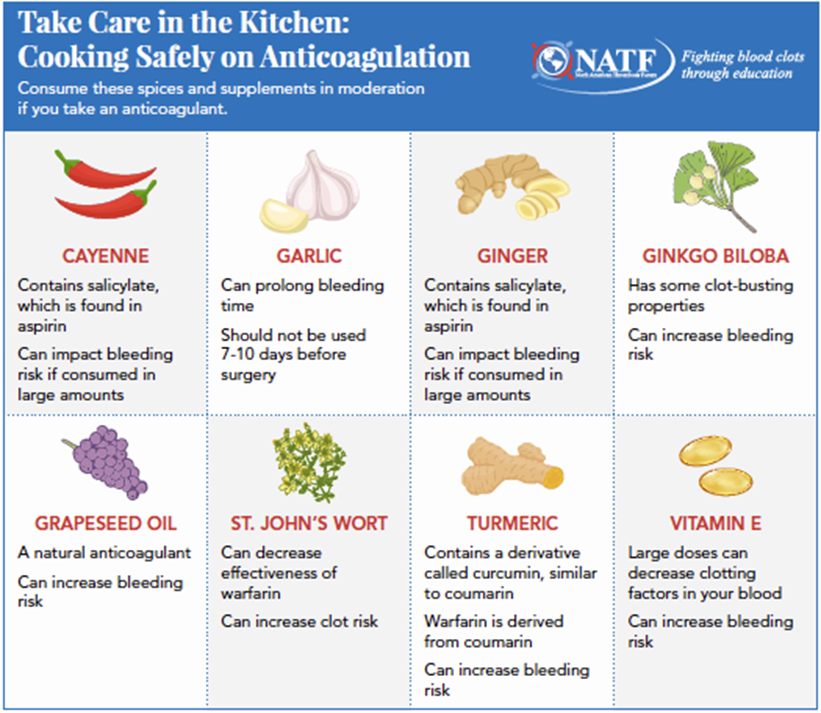The patient is to be started on warfarin (Coumadin) therapy. It is important for the nurse to check for the use of which herbs? (Select All that Apply)
Valerian
Ginkgo biloba
Echinacea
Ginger
Garlic
Correct Answer : B,C,D,E
A. Valerian:
Valerian is an herb commonly used for its sedative and anxiolytic properties. There is limited evidence suggesting potential interactions between valerian and warfarin, but it is not considered a major concern for altering warfarin's anticoagulant effects. However, caution is still warranted, and healthcare providers should monitor patients for any signs of increased bleeding if they are using valerian along with warfarin.
B. Ginkgo biloba:
Ginkgo biloba is an herb often used for its cognitive-enhancing properties and to improve circulation. There is some evidence to suggest that ginkgo biloba may interact with warfarin and increase the risk of bleeding due to its anticoagulant effects. Therefore, patients taking warfarin should use ginkgo biloba cautiously and inform their healthcare providers if they are using it.
C. Echinacea:
Echinacea is an herb commonly used to boost the immune system and treat colds and respiratory infections. Some studies suggest that echinacea may interact with warfarin and potentially increase the risk of bleeding. Therefore, it's essential for patients taking warfarin to avoid or use echinacea cautiously and to inform their healthcare providers if they are using it.
D. Ginger:
Ginger is an herb commonly used for its anti-inflammatory and digestive properties. Some studies suggest that ginger may interact with warfarin and increase the risk of bleeding due to its anticoagulant effects. Patients taking warfarin should use ginger cautiously and inform their healthcare providers if they are using it.
E. Garlic:
Garlic is an herb known for its cardiovascular benefits and potential anticoagulant effects. Some studies suggest that garlic may interact with warfarin and increase the risk of bleeding. Patients taking warfarin should use garlic cautiously and inform their healthcare providers if they are using it.

Nursing Test Bank
Naxlex Comprehensive Predictor Exams
Related Questions
Correct Answer is A
Explanation
A. The patient stops taking the drug when he or she begins to feel better:
This choice refers to the common habit where patients discontinue their prescribed medication once they start to feel improvement in their symptoms, even if they haven't completed the full course of treatment. This premature cessation of medication can leave some microbes alive and potentially resistant to the antibiotic, allowing them to regrow and cause a recurrence of the infection.
B. The patient switches to multiple drug therapy from single drug therapy:
This choice describes a scenario where a patient switches from a single drug therapy to multiple drug therapy. While this may be a valid treatment approach in some cases, it is not directly related to the re-population and re-establishment of microbes causing an infection.
C. The patient uses OTC drugs prophylactically:
This choice involves patients using over-the-counter (OTC) drugs preventively without consulting a healthcare professional. While OTC drugs may have their own set of issues, such as contributing to antibiotic resistance, this behavior isn't specifically linked to the re-population and re-establishment of microbes causing an infection.
D. The patient increases the drug dosage when he or she perceives that the therapeutic effect of the drug is slowing down:
This choice describes a scenario where a patient independently increases the dosage of their medication without consulting a healthcare provider. While inappropriate dosage adjustments can lead to adverse effects, it doesn't directly address the re-population and re-establishment of microbes causing an infection.
Correct Answer is A
Explanation
A. Ototoxicity:
Ototoxicity refers to damage to the auditory and vestibular nerves, leading to hearing loss and balance disturbances. Gentamicin, being an aminoglycoside antibiotic, is known for its potential to cause ototoxicity. Signs and symptoms of ototoxicity include changes in hearing, ringing in the ears (tinnitus), and imbalance. Ototoxicity is irreversible and can occur suddenly or gradually during gentamicin therapy. Therefore, any signs or symptoms of ototoxicity should be reported immediately to the physician for further evaluation and management.
B. Nausea:
Nausea is a common gastrointestinal side effect associated with gentamicin therapy. While it can be bothersome to the patient, nausea alone is not typically considered a severe adverse effect that requires immediate reporting to the physician. However, if nausea is severe or persistent and leads to dehydration or electrolyte imbalances, it should be addressed promptly.
C. Constipation:
Constipation is another potential gastrointestinal side effect of gentamicin therapy. Like nausea, constipation alone is not typically considered a severe adverse effect that requires immediate reporting to the physician. However, if constipation is severe or persistent and leads to discomfort or bowel obstruction, it should be addressed promptly.
D. Increased urinary output:
Increased urinary output may indicate improved renal function, which can be a desired effect during gentamicin therapy. Gentamicin is primarily excreted by the kidneys, and increased urinary output may help in the elimination of the drug from the body. Therefore, increased urinary output alone is not typically considered an adverse effect that requires immediate reporting to the physician. However, if there are signs of dehydration or electrolyte imbalances associated with increased urinary output, they should be addressed promptly.
Whether you are a student looking to ace your exams or a practicing nurse seeking to enhance your expertise , our nursing education contents will empower you with the confidence and competence to make a difference in the lives of patients and become a respected leader in the healthcare field.
Visit Naxlex, invest in your future and unlock endless possibilities with our unparalleled nursing education contents today
Report Wrong Answer on the Current Question
Do you disagree with the answer? If yes, what is your expected answer? Explain.
Kindly be descriptive with the issue you are facing.
